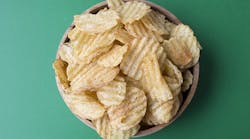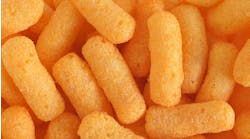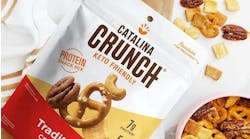By now, the "snackification" of America is well chronicled. Three square meals a day have given rise to more but smaller eating occasions. Even when they haven't, Americans feel they have a right to snack in between. And the rest of the world is following suit.
As a result, the big food companies – and not just the big snack companies – are paying a lot of attention to this growing, broadening category. Campbell Soup in 2017 bought Snyder's-Lance. That same year, Hershey acquired Amplify Brands (www.amplifysnackbrands.com), maker of SkinnyPop. Kellogg long ago snagged Pringles. Mondelez was spun off from Kraft in 2012 as a pure-play snack company.
"Snack" can mean almost anything short of a full meal, but the core remains salty snacks. Potato chips still reign, accounting for 25 percent of all sales, according to Market Research Reports (www.marketresearchreports.com), followed by corn and tortilla chips at 20 percent and roasted nuts and seeds accounting for another 20 percent.
- When is a snack more than just a snack? When it boosts the bottom line. We look at how healthy snacks are for consumers and processors in our coverage: Snacks Can Be Healthy – For Consumers and Processors
In addition to those, SNAC International, formerly the Snack Food Association, includes such categories as: pretzels, popcorn, crackers, cookies, bars, pork rinds, corn snacks, cheese snacks, meat snacks, dips/salsas/spreads and apple chips.
"Healthy snacks" is no longer an oxymoron, and it presents the biggest current opportunity across the category. Healthy is in the eye of the beholder, but it can be achieved by reductions of what consumers perceive as bad (fat, calories, sodium, sugar, even gluten) or the addition of good things (protein, especially plant proteins, fiber, fruits and vegetables).
The U.S. snack foods manufacturing industry comprises approximately 500 companies with combined annual revenue of $30 billion, says Market Research Reports. Key growth drivers are expanding convenience store sales, tree nut sales and spicier offerings. Issues to navigate include changing consumer tastes, busy lifestyles and health considerations.
[pullquote]
Simpler ingredients, bigger flavors
Snacks seem more resistant, although not immune, to the general ingredient trends impacting other food categories. That means simpler, more recognizable ingredients and the removal of synthetic ones plus bolder, often ethnic-inspired flavors.
All those trends play out in potato chips. Ethnic flavors are popular with Kettle Brand, which, as an independent company, held annual "People's Choice" contests to have consumers suggest new flavors. While that campaign was retired in 2009 and Kettle is now a part of Campbell Soup, Krinkle Cut Buffalo Bleu, the 2006 People's Choice winner, remains. Kettle has plenty of other novel flavors, many ethnically inspired, such as Fiery Thai, Korean Barbecue, Chili Verde, Tropical Salsa, Sriracha and Pepperoncini.
Herr's Foods Inc. (www.herrs.com), an eastern Pennsylvania maker of salty snacks, also has a history of innovative flavors. "Since flavors are very important to our product line, our marketing and R&D teams stay pretty dialed-in to changing consumer tastes," says Bob Clark, vice president of marketing. "We tap a broad spectrum of sources – restaurant menu trends, ingredient suppliers, flavor trends in other food categories and customers suggestions -- when coming up with new ideas for flavors for our snacks."
The results have been such flavors as ketchup (at one time branded as Heinz), baby back ribs, Kansas City prime steak and cheddar horseradish.
"We screen a wide range of ideas with consumers each year and find those that are best liked and are unique," Clark continues. "We try to always include ideas that are slightly more trendy just to see how they rate as a possible snack flavor. Certain ideas are more applicable for limited time/seasonal offerings while others are mainstream and can be added permanently."
However, classic flavors remain favorites -- things like simple salt (although increasingly sea salt), barbecue (sometimes with regional variations like Memphis BBQ), cheese (cheddar in particular), garlic, sour cream and onion. Jalapeno, which for a while gave way to sriracha, is back.
Many salty snacks, especially chips, have oil in both their formulations and the fryers that cook them. So careful selection of oil is becoming important.
High-oleic soybean oil offers snack food companies the chance to improve products’ nutritional profile, says Frank Flider, oils consultant for Qualisoy (qualisoy.com), a collaboration among the soybean industry. "High-oleic soybean oil is high in monounsaturated fats, stable and does not require hydrogenation, making it a better-for-you replacement for fats and oils higher in saturated fats," he says.
Likewise, non-GMO sunflower oil comes in mid- and high-oleic formats and offers superior stability and extended fry and shelf life, says the National Sunflower Assn. (www.sunflowernsa.com). Sun oil is Kosher and Halal certified, with a light neutral taste offering a clean flavor profile, ideal for the formulation of snacks, the association asserts.
How to make all those variations
All those variations in snacks, in terms of their ingredients, shapes and packaging, place demands on the equipment that must handle, process and package them. As snack pieces become more fragile and diverse and packaging becomes smaller and more customized, equipment must adapt.
“One of the biggest trends that will continue to drive the future of the snack food industry is the ongoing consumer demand for healthier snack options,” says Shayne De la Force, chief marketing officer for TNA Solutions (www.tnasolutions.com). “In an effort to increase market share and enhance the healthy profile of their snacks, a lot of manufacturers have therefore started to experiment with new processing techniques and ingredients.”
Snack processing equipment often must accommodate unique shapes and ingredients. Photo: Clextral
These include alternative ingredients like flour made from ancient grains and whole seeds, or chips made from fruits like with banana, kiwi and coconut.
“Generally speaking, the main priority when experimenting with new ingredients is to avoid any changes to the product’s sensory qualities,” De la Force says. “For example, ingredients such as beets, plantain, sweet potato or carrots contain high levels of starch and/or reducing sugars. When processed at high temperatures (above 240°F, optimum above 320°F), the reducing sugars caramelize and participate in the Maillard reaction, leading to browning.” Even temperatures above 190°F can break down nutrients such as vitamins A and C, while, in some cases, resulting in a bland appearance and taste.
As a way to avoid these problems, TNA offers vacuum fryers like the Florigo vac-pro3. The vacuum allows frying to occur at lower temperatures, while reducing oxidation of the oil, allowing a greater choice of oils, including flavored ones.
Adjusting for baking
Baking is a well-established alternative to frying for better-for-you snacks. But that places its own demands on processing equipment, especially with extruded snacks.
“For extrusion, we use different formulations to generate the textures and expansion levels similar to frying and achieve a mouthfeel which will be accepted by consumers – always knowing that a fried and a baked product will be different at the end,” says Gilles Maller, vice president of sales and international for Clextral (www.clextral.com).
These and other trends place certain demands on material handling and packaging. For instance, some snacks, especially extruded ones, are taking on exotic shapes, which can increase consumer appeal but also fragility.
Fragility and unusual shapes place demands on automatic sorting. Photo: Key Technology
“We find that some of those shapes may be very appealing at first but represent a challenge at the packaging stage where they require special handling to avoid damage,” Maller says.
Automatic sorting, done though machine vision, has been used for a long time to remove undesirable elements like foreign material and burned pieces. But processors of some of the more exotic shapes are using it to ensure conformity, especially in cases where an unusual shape results in increased fragility.
“Historically, snack food processors have relied on digital sorting to identify and remove foreign material and a wide assortment of color defects from their products,” says Bret Larreau, Key Technology's (www.key.net). global account manager for PepsiCo Frito-Lay. “Shape sorting, which has been used by fruit and vegetable processors for many years, is now being adopted by some snack food processors.
We have customers producing specialty snacks who want to be sure their products comply with their shape standards.”
Size matters
Trends in snacks also affect packaging. As with many product categories, trade customers are demanding ever more size varieties. With snacks, portion control is a frequent motivation.
“For many manufacturers, reducing the size of their bags is another solution to offer consumers convenience and calorie control without jeopardizing their brand loyalty,” De la Force says. “Small single-serve bags tick all the right boxes. They’re quick, pre-portioned, convenient and don’t require reformulation. As a result, bag sizes have gradually decreased over the years from 1 lb. to 4 oz. and 1 oz. bags. In fact, 100-calorie bite-size snack bags are almost ubiquitous in grocery aisles around the world and they’re here to stay.”
- Better-for-you snack manufacturers must clear production hurdles to chase opportunities. Read more about it at The Hurdles of ‘Clean’ and Better-for-You Snacks
But these present challenges for packaging equipment. Most vertical form-fill-seal (VFFS) equipment, the most common choice for lightweight snacks like potato chips, can only run up to 140 bags a minute. To keep up with a processing pace of 600 lbs. per hour, a chip maker who went from 2-oz. to 1-oz. bags would have to install a second machine, De la Force points out.
As an alternative, TNA has its “performance 5.0” system, comprising the Robag 5 VFFS system and its new TNA Ropac 5 case packer, which can deliver up to 300 1-oz. bags per minute.
Similarly, Rovema NA has developed the BVC 145 TwinTube FFS machine, capable of filling up to 500 bags per minute with two filling tubes, from a single film web split in two.


